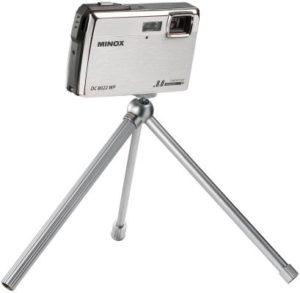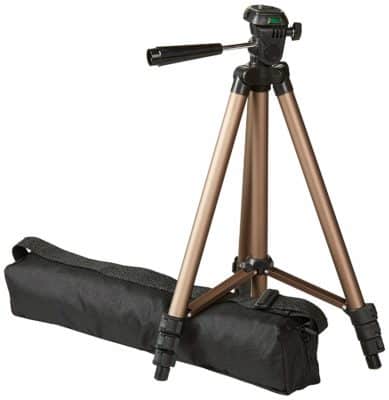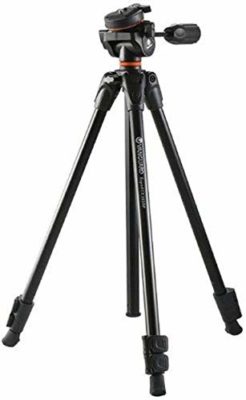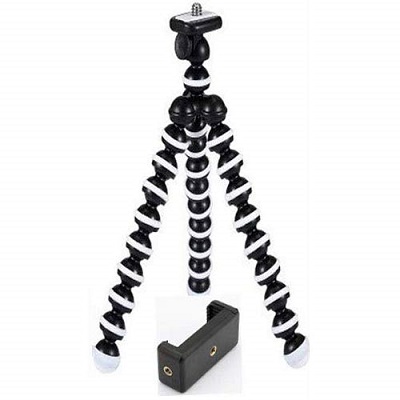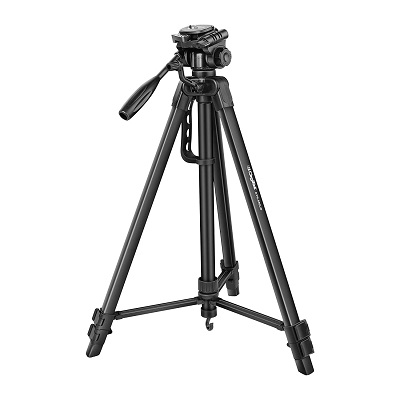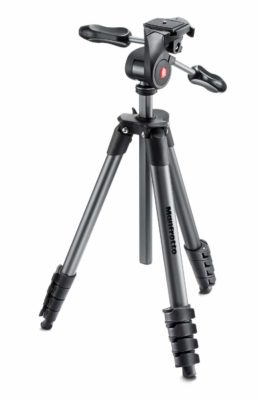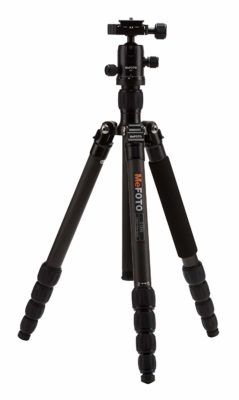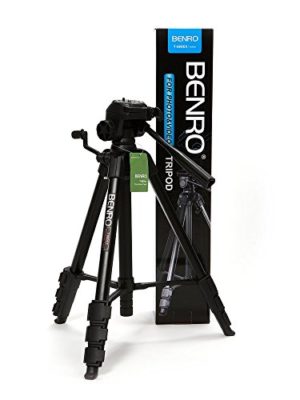Top 7 Best Selling Tripods in India
The recent scores of years have witnessed the evolution of photography from a science(of creating permanent images) to an art form(of creating pleasing pictures!!). From an activity with a primary function of getting images for official documents, photography has become a hobby for many, and a profession for others.
Along with a camera(of course!)and all the other paraphernalia, tripods have become one of the most used accessories helping enthusiasts and professionals alike, in clicking great pictures, to their heart’s content.
Tripods are primarily used by photographers for the stability of the camera when clicking in low light situations and when using slow shutter speeds. Physical instability of the camera in such conditions can lead to a blurred picture. They are also used for support of the heavy camera and lens and to minimize the vibrations in the camera.
You even get tripods for smartphones so that people can record good quality videos from the phone itself.
With the wide array of tripods available in the market for grabs, not being able to choose the right one as per your specific requirements could leave you cheesed off with yours. A good number of elements must be kept in mind while considering buying a tripod.
Questions like:
Should I get an aluminum one or the trendy carbon fiber one?
How heavy or tall should my tripod be?
What should be the amount that I ought to spend on my tripod?
Will the single-leg tripod work as efficiently as the conventional three-legged body?; will arise in your mind and need to be answered correctly and with thorough understanding.
In this article, we aim to do just that by answering those questions and helping you understand the key points to keep in mind before equipping yourself for your next clicking session.
Let’s begin with a primary classification of tripods into categories of a tripod, buyers guide, and FAQ’s. Lastly, we have also mentioned Our Top Picks.
Top 7 Best Tripods in India
Categories of Tripods
Pocket Tripod
Pocket tripods are mini optimizations of the standard tripod, made as such, keeping portability as the topmost priority for the user. They stand at 4-8 inches in size at the maximum. They are not much use when it comes to professional snapping, but can be useful for anytime “selfies” or family pictures by placing them on a tabletop or a similar surface.
They cannot be placed on the ground for taking pictures owing to their small size that restricts their perspective and to their construction that limits their ability to support a full-fledged DSLR. However, they are ideal for small mirrorless cameras.
Travel Tripod
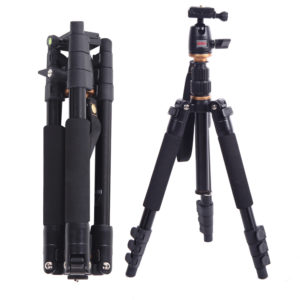 If you are a nature lover and love going out on hikes or trips/tours just to get those serene clicks to stir your aesthetic senses, this is just the thing for you. Travel tripods are great when it comes to portability and can support DSLRs to help you get the best of photos.
If you are a nature lover and love going out on hikes or trips/tours just to get those serene clicks to stir your aesthetic senses, this is just the thing for you. Travel tripods are great when it comes to portability and can support DSLRs to help you get the best of photos.
Though they compromise a bit on functionality as a tradeoff to portability, as they might be unable to support cameras with an additional zooming lens. Compact video cameras could be used with them too.
As is pretty obvious from the name, these are substantially beneficial to travelers. Some of the small ones could even fit in airline luggage. To keep a check on the weight, they are generally made of plastic or carbon fiber.
Monopod
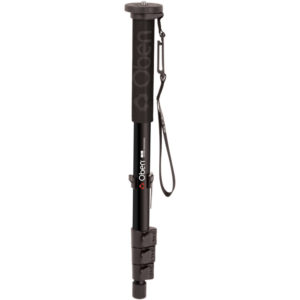 Monopods are modified tripods with only one leg. They are useful as they obliterate camera shake to an absolute zero. With just one leg, they stand lighter and easier to carry and handle as compared to the standard tripod.
Monopods are modified tripods with only one leg. They are useful as they obliterate camera shake to an absolute zero. With just one leg, they stand lighter and easier to carry and handle as compared to the standard tripod.
Though they restrict the cameraman’s movement to a large extent, they are still bliss to wildlife and sports photographers who find easy support a welcome relief from the weight of the camera.
Interestingly, monopods can come in handy in places like a studio where they allow a good deal of freedom to the cameraman to move around in contrast to the three-legged structure.
Studio Tripod
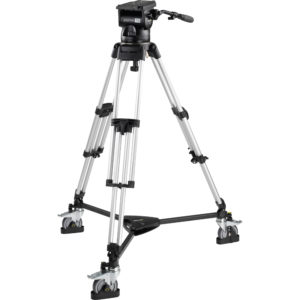 Studio tripods are heavy-duty tripods meant for professional use and handling a large front camera. They are generally big and bulky as compared to the others and not recommended for traveling with.
Studio tripods are heavy-duty tripods meant for professional use and handling a large front camera. They are generally big and bulky as compared to the others and not recommended for traveling with.
You ought to buy a studio tripod if either you wish to use it for static use, i.e., in a studio(duh!!), or if you wish to put it to specific professional use. Otherwise, a travel tripod will suffice to satisfy all your outdoor and indoor needs.
Specialized Tripod
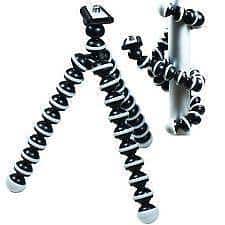 Specialized tripods are special function tripods to provide you with better options in terms of placement of the tripods to take photographs from various angles or at different places. These are generally used for custom uses or highly customized and specific applications.
Specialized tripods are special function tripods to provide you with better options in terms of placement of the tripods to take photographs from various angles or at different places. These are generally used for custom uses or highly customized and specific applications.
Some of the types are Suction Cup Tripods and Flexible legs tripods. To give an example, you could wrap a flexible leg tripod around a tree stem or a rock at the beach to take a photo.
Now that we have gathered a fair idea of the tripod type choices that we have, we need to give consideration to the various aspects that decide what makes a tripod fit for your use. As a prospective buyer of a tripod, you must weigh the following elements in order to arrive at the one that you will be bringing home.
Tripod Buyer’s Guide
Here is a list of a few specifications that the buyer should keep in mind while looking to buy a tripod.
Stability
The tripod should have a strong and sturdy design so that you get the best shots even in the toughest outdoor surfaces. The tripod you purchase should have a lever lock legs that secure the legs into a fixed position. The legs should also have rubber feet to enhance the overall stability of the model.
Collapsing Size
Collapsing size refers to the size of the tripod when it is closed. This is an important factor as it decides which of the aforementioned categories your tripod falls into. With this information, you can easily choose one which fits your requirements.
Weight
The weight of the tripod that you will be using should be at your convenience, and that I feel is the only driving factor while considering the weight. For example, if you would be traveling a lot, it is prudent to choose a lighter one. If you are to be using it in your studio, you might go for a heavier model with better features.
Tripods made of carbon fiber are lighter as compared to those of aluminum, though the former are considerably expensive as compared to the latter.
Maximum Height Extension
The fundamental function of the tripod is to enable you to place the camera at a variety of heights to position it perfectly. Therefore, extension height is one of the prime considerations for a tripod. Your own height can be the guide to decide the maximum height of your tripod.
If it falls too short, the cameraman will have to bend down, making him uneasy. Moreover, every extra centimeter can come in handy when shooting on uneven terrain or over obstacles.
Load Rating
The tripod must be able to support the weight of the camera equipment. You must be careful to choose that, it can support a weight that is fairly larger(approximately 1.25 times -1.75 times) as compared to what you plan to use. This is to keep a margin of safety.
While you shoot, you place your hands over the camera and exert some extra force that the tripod has to support. This should be taken into account. Moreover, you might add some additional equipment such as a battery grip or use a heavier camera in the future, and a slightly higher rating will take care of that.
Tripod Head
A tripod head does not come with the tripod and has to be bought separately. The head secures the camera to the tripod and controls its movement. The head and the tripod should have the same load ratings so that you don’t face any problems with either.
The tripod heads come in different forms, pan-tilt, ball-head, gimbal head, to name the predominantly available types. The pan-tilt head has a single control or a dual one depending on allowing movement in one direction(horizontal) or both directions(horizontal and vertical).
The ball-head is better than pan-tilt as it is flexible and has a better operation with better security for the camera. The gimbal head is a special head to be used for heavier lenses.
Construction Material
Keep in mind that the material is important for deciding the strength and the eventual weight of the tripod. Tripods are generally made of aluminum, carbon fiber, and titanium, though wood might also be used in larger tripods.
Pocket tripods are made up of plastic too, in addition to the other materials that have been mentioned. Aluminum and Titanium tripods are heavier and cheaper as compared to the carbon fiber tripods.
It should be noted that when it comes to sturdiness, aluminum beats carbon fiber. Aluminum will take a shock, and depression will be the result, but there are possibilities that a carbon fiber tripod will snap at the same shock.
Quick Release System
A quick release system is available for securing the camera to the head. The best-known system is the Arka Swiss quick release system, which is used as an informal standard among manufacturers of the quick release system.
This system is an improvement over the previously used threaded system, which was highly inconvenient and cumbersome to use. Buying one with this system would help you in smooth operation.
So far, we have had a look at the essentials to be mindful of when buying a tripod. Now, we discuss some of the best products available that you could buy and why you should buy them.
1. AmazonBasics 50-Inch Lightweight Tripod
The AmazonBasics tripod has a sturdy and strong design made of aluminum. The 3 section lever lock legs with rubber feet can be adjusted to a height of 50 inches. It can also be used in different locations easily because of its compact and collapsible design that allows you to carry it along with you in the zippered bag. On the other hand, the quick release plate ensures smooth transitioning and movement between shots and locations.
- The tripod weighs 567 grams.
- Ideal for digital video or still cameras.
- It features a 3-way head that enables 360-degree swivel and tilt while the knobs secure into position.
- Comes with a quick release mounting plate to release your camera fast from a tripod so that transitioning and moving between locations become quick.
- 3 section lever lock legs can be adjusted to a full height of 50 inches.
- The extendable gear-less center post helps in movement and adjustment of height.
- Made with sturdy aluminum.
- Has a collapsible design which allows it to be folded, legs can be contracted, and the handles can rotate downwards.
- Comes with a zippered bag.
- Light-weight, compact, and collapsible design makes it easily portable, and the zippered bag helps in safe storage.
- The lever log legs with rubber feet ensure stability so that you get the perfect shots.
- The 3-way head provides versatility allowing you to easily change from landscape to portrait mode.
- Sturdy and robust design.
- The tripod bends and can not hold the load of DSLR cameras.
2. Vanguard CX203AP Espod Tripod Aluminum
Vanguard has been delivering tripods in the market at affordable prices without compromising quality. Vanguard has aimed at the ESPOD CX203 AP at amateurs and serious enthusiasts.The tripod can hold most of the DSLRs allowing you to work with a lot of different cameras.
The aluminum body is not too heavy and can accompany you on any of your long trips. The rubber grip at the feet gives the tripod a better grip, and sturdy flip locks are a bonus. The height can vary from a meager 590 mm to 1500 mm, which is a pretty decent range to work with and has a single bubble level for precision.
- Maximum Loading Capacity: 3.5 kgs
- Material: Aluminum
- Weight: 1.1 kgs
- Extended Height: 61 inches
- Folded Height: 22.625 inches
- Pop and unlock Quick shoe release and its ease of use
- Central Column anti-shock ring steadies the whole structure
- Lightweight and easy to carry
- Quick Flip Leg Locks
- Highly attractive price
- Pan head ergonomic handle positions smoothly and easily
- Loading capacity could have been better
- Cannot work with heavy lenses and camera equipment
- No fluid head
- Not good enough for panning. Movements are restricted
3. Tygot 13 inch Flexible Gorillapod Tripod
Tygot Flexible Gorillapod Tripod is a heavy duty product made of high quality ABS material for durability and long life. This material and build ensures safety of mobile phones, camera, DSLR and the tripod during rough usage.
It has a sturdy hold on angle while shooting and comes with a 360 degree rotation function for perfect photography and videography. It has a great load bearing capacity of the weight of different devices.
- It comes with an anodized finishing rotating spheres for great load bearing capacity
- Heavy duty, durable high quality ABS material ensures safety of the devices
- The universal of 1/4 inch screw secures the mount
- The clasp lock with fail proof mechanism ensures secure tight angles while shooting
- It is comfortable and can be used for long duration
- Portable and lightweight build ensures that it can be carried anywhere effortlessly
- It allows usage in rough conditions and environment
- This tripod allows 360 degree rotation for perfect captures
- Steady legs ensure easy hold and do not slip
- It does not provide proper weight management
- Quality could have been better
4. DIGITEK DTR 550 LW 67 Inch Tripod
Digitek DTR Tripod provides stable camera support for low-light shooting, long exposures, panning shots, panoramas and more. It is suitable for novice as well as professional photographers.
It comes with user-friendly features. This product is compatible with most video cameras, digital cameras, still cameras, GoPro devices, Smartphone adapters.
- It has an operating height of 5.57 feet and maximum load capacity up to 4.5kg
- Aluminum alloy legs have non-slip rubber feet for sturdy placement
- The legs come with three flip-up locks for adjusting the height of each leg on uneven surfaces
- The three way head allows easy change of orientation of the camera
- It comes with a clip lock system
- This accessory provides stable camera support for best captures
- It is easy to fit and remove the camera with the quick release mounting plates
- This product promotes fast transitions between shots and t move quickly from location to location
- It has a portable lightweight aluminum build
- A little heavy
5. Manfrotto MKCOMPACTADV-BK Compact Advanced Tripod
Manfrotto Compact Advanced Tripod is an aluminum body and yet light enough for you to haul it on your back and carry with you to your next camping trip. The three-way folding head is an advantage with highly maneuverable controls for pan/tilt and leveling.
A bubblehead is missing, but that can be added once you have this excellent tripod stacked up in your home. A circular quick release plate with a scroll wheel mechanism makes attaching a camera very simple.
- Maximum Loading Capacity: 3.3 kgs
- Material: Aluminum, Technopolymer
- Weight: 1.4 kgs
- Extended Height: 65.75 inches
- Folded Height: 18.31 inches
- Lightweight and easy to carry
- Small size
- High stability and sturdiness
- Maximum height is an added advantage
- Reinforced aluminum for outstanding rigidity
- Fluid head absent
- Cannot handle larger cameras
- No bubble level
6. MeFOTO Classic Carbon Fiber Tripod
This is a well-engineered product with a minimal folded length of 40 cm, including the quick release plate, providing high portability to the user. The feet grip is good, and that makes it stable. The tripod can be converted to a monopod by removing one of the legs and putting it together with just the center column, just in case you are looking for a little less weight.
The weight difference of this carbon fiber to the aluminum one is only about 225 grams, so you might think of opting for the aluminum model as it is considerably cheaper, if you don’t mind the weight difference so much
- Maximum Loading Capacity: 8.8 kgs
- Material: Carbon fiber, Aluminum
- Weight: 1.50 kgs
- Extended Height: 61.6 inches
- Folded Height: 15.4 inches
- Compact and lightweight
- Appreciable Load capability
- Easy setup and breakdown
- Can be converted to a monopod
- Easy adjustability
- Expensive
- Turning locks not easy to handle
- Flimsy legs
- Tripod is not sturdy enough
7. Benro T880EX Digital Tripod Kit
The tripod is extremely light in spite of the aluminum body and does not promise stability that we have witnessed among the other tripods that have been discussed. The lightweight and a small folded height, high portability is a surety, but you can experience a certain jiggle and teeter that is sure to bother you while taking shots, and that goes against the product.
- Maximum Loading Capacity: 3 kgs
- Material: Aluminum
- Weight: 1.45 kgs
- Extended Height: 57.48 inches
- Folded Height: 18.50 inches
- The four-legged section allows for more flexibility
- Three-way panning head
- Precise panning and tilting
- Highly limited load capacity
- Wobble in the legs
- Less maximum height
Frequently Asked Questions
1. What is the alternative to a tripod?
Some of the alternatives to a tripod are as follows:
- Monopod
- You can make use of the top part of a bottle containing water to hold your small camera.
- Suction mounts
- Clamps
- Pocket tripods
- Use the environment, for example, place the camera on the surface of any solid object with a flat surface like a tree stump, wall, park bench, etc.
2. What are the benefits of using a tripod?
The benefits of using a tripod are as follows:
It helps you take sharper images by adding stability and support. There is no fear of movement which would otherwise disrupt your photography.
It helps in clicking pictures in every condition, i.e., even in low lighting as it allows the use of long exposure.
It helps in framing and focusing better.
3. Which is the best tripod for wildlife photography and landscape photography?
Some of the best tripods for wildlife and landscape photography usually come with a 3-way head that allows easy change from portrait to landscape.
A few examples are:
The AmazonBasics 50 Inch Light-weight Aluminium Tripod.
Manfrotto Compact Advanced 3 Way
4. What is the difference between monopod and tripod?
A monopod is a modified version of a tripod that comes with only one leg, unlike the traditional tripod that features 3 legs. A monopod is much more light-weight and compact compared to a tripod and provides the cameraman freedom of movement. Tripods are great for outdoor use, while a monopod is ideal for studios.
Conclusion
After having had a comprehensive understanding and looked at some of the must-have tripods, your choice to buy depends on your budget and application.
If you have been doing photography for some time now and wish to explore, the AmazonBasics Tripod is just the choice for you.
However, if you are a newbie and are just beginning, we recommend you go with the Vanguard ESPOD CX203 AP.
If you are a professional in the field, you could buy either of MeFOTO RoadTrip Carbon fiber Travel Tripod





